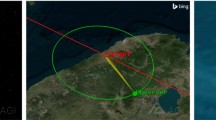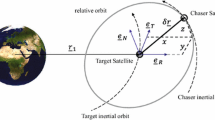Abstract
Mode and logic-based switching for formation flying control is motivated and addressed in the context of separated spacecraft optical interferometry. In this venue, we show that logic-based switching is an attractive approach for satisfying multiple performance criteria during the different phases of a representative formation flying mission. Simulation results are provided to demonstrate the viability of the proposed methodology.
Similar content being viewed by others
References
AKMAD, A., ALEXANDER, J., BOUSSALIS, D., BRECKENRIDGE, W., MACALA, G., MESBAHI, M., SAN MARTIN, M., SINGH, G., and WONG, E. “Cassini Project Control Analysis Book, “ Jet Propulsion Laboratory, California Institute of Technology, 1997.
DAVIS, J. “Measuring Stars with High Angular Resolution: Current Status and Future Prospects, “ in Calibration of Fundamental Stellar Quantities, D. S. Hayes, L. E. Pasinetti, and A. G. D. Philips (Editors), Reidel Dordrecht, 1985.
STACHNIK, R., ASHLIN, K., and HAMILTON, K. “Space-Station-SAMSI: A Spacecraft Array for Michelson Spatial Interferometry, “ in Bulletin of the American Astronomical Society, 16:818–827, 1984.
Terrestrial Planet Finder: Origins of Stars, Planets, and Life, Jet Propulsion Laboratory, California Institute of Technology, May 1999.
BORN, M. and WOLF, E. Principles of Optics (sixth edition), Cambridge, 1997.
DECOU, A. B. “Multiple Spacecraft Optical Interferometry-Preliminary Feasibility Assessment, “ technical report, Jet Propulsion Laboratory, 1991.
WANG, P. K. C. and HADAEGH, F. Y. “Coordination and Control of Multiple Microspacecraft Moving in Formation, “ Journal of the Astronautical Sciences, 44(3):315–355, 1996.
WANG, P. K. C., HADAEGH, F.Y., and LAU, K. “Synchronized Formation Rotation and Attitude Control of Multiple Free-Flying Spacecraft, “ Journal of Guidance, Control, and Dynamics, 22:28–35, 1999.
The Starlight Mission, Jet Propulsion Laboratory, California Institute of Technology, 1998.
LAU, K. “The ST3 Requirements Document, “ Jet Propulsion Laboratory, California Institute of Technology, 1999.
ANTSAKLIS, P., KOHN, W., NERODE, A., and SASTRY, S. (Editors) Hybrid Systems 4, Lecture Notes in Computer Science, Springer-Verlag, 1997.
MESBAHI, M. and HADAEGH, F.Y. “Formation Flying Control of Multiple Spacecraft via Graphs, Matrix Inequalities and Switching, “ Journal of Guidance, Control, and Dynamics, 24(2): 369–377, March-April 2001.
MORSE, A.S. “Control Using Logic Based Switching, “ in A. Isidori, editor, Trends in Control: A European Perspective, Springer-Verlag, 1995.
BRANICKY, M. S. “Multiple Lyapunov Functions and Other Analysis Tools for Switched and Hybrid Systems, “ IEEE Transactions on Automatic Control, 43:475–482, 1998.
BROCKETT, R.W. “Hybrid Models for Motion Control Systems, “ in H. L. Trentelman and J. C. Willems, editors, Essays in Control, pages 29–53 Birkhauser, 1993.
MALMBORG, J., BERNHARDSON, B., and ASTROM, K.J. “A Stabilizing Switching Scheme for Multi-Controller Systems, “ In Proceedings of the IFAC World Congress, San Francisco, CA, 1996.
PAVLIDIS, T. “Stability of Systems Described by Differential Equations Containing Impulses, “ IEEE Transactions on Automatic Control, 12:43–45, 1967.
STENGEL, R. F. Optimal Control and Estimation, Dover, 1994.
BEARD, R.W. and HADAEGH, F.Y. “Fuel Optimization for Unconstrained Rotation of Spacecraft Formations, “ Journal of Astronautical Sciences, 43(3): 259–273, July-Dec. 1999.
BEARD, R.W. and HADAEGH, F.Y. “Finite Thrust Control for Satellite Formation Flying with State Constraints, “ In Proceedings of the American Control Conference, 1998.
KAILATH, T. Linear Systems, Prentice-Hall, Englewood Cliffs, New Jersey, 1980.
BOYD, S. P., GHAOUI, L. EL, and BALAKRISHNAN, V. Linear Matrix Inequalities in System and Control Theory, SIAM, Philadelphia, 1994.
MESBAHI, M., SAFONOV, M. G., and PAPAVASSILOPOULOS, G. P. “Bilinearity and Complementarity in Robust Control, “ In Recent Advances on LMI Approach in Control, SIAM, Philadelphia, 2000.
NESTEROV, Y. and NEMIROVSKII, A. Interior-Point Polynomial Algorithms in Convex Programming, SIAM, Philadelphia, 1994.
StateFlow User Manual, Mathworks, 1998.
Author information
Authors and Affiliations
Corresponding author
Rights and permissions
About this article
Cite this article
Mesbahi, M., Hadaegh, F.Y. Mode and Logic-Based Switching for the Formation Flying Control of Multiple Spacecraft. J of Astronaut Sci 49, 443–468 (2001). https://doi.org/10.1007/BF03546232
Published:
Issue Date:
DOI: https://doi.org/10.1007/BF03546232




